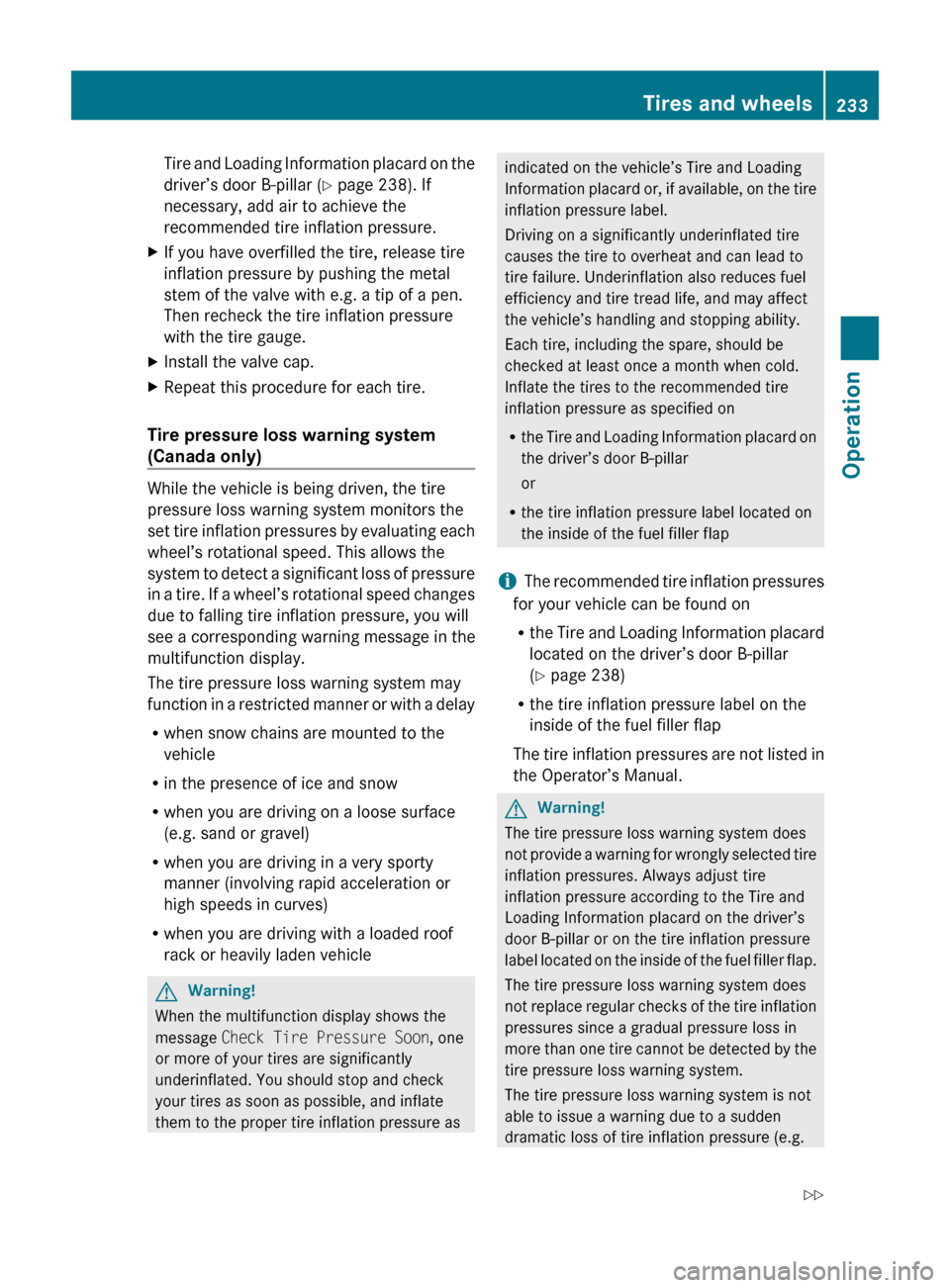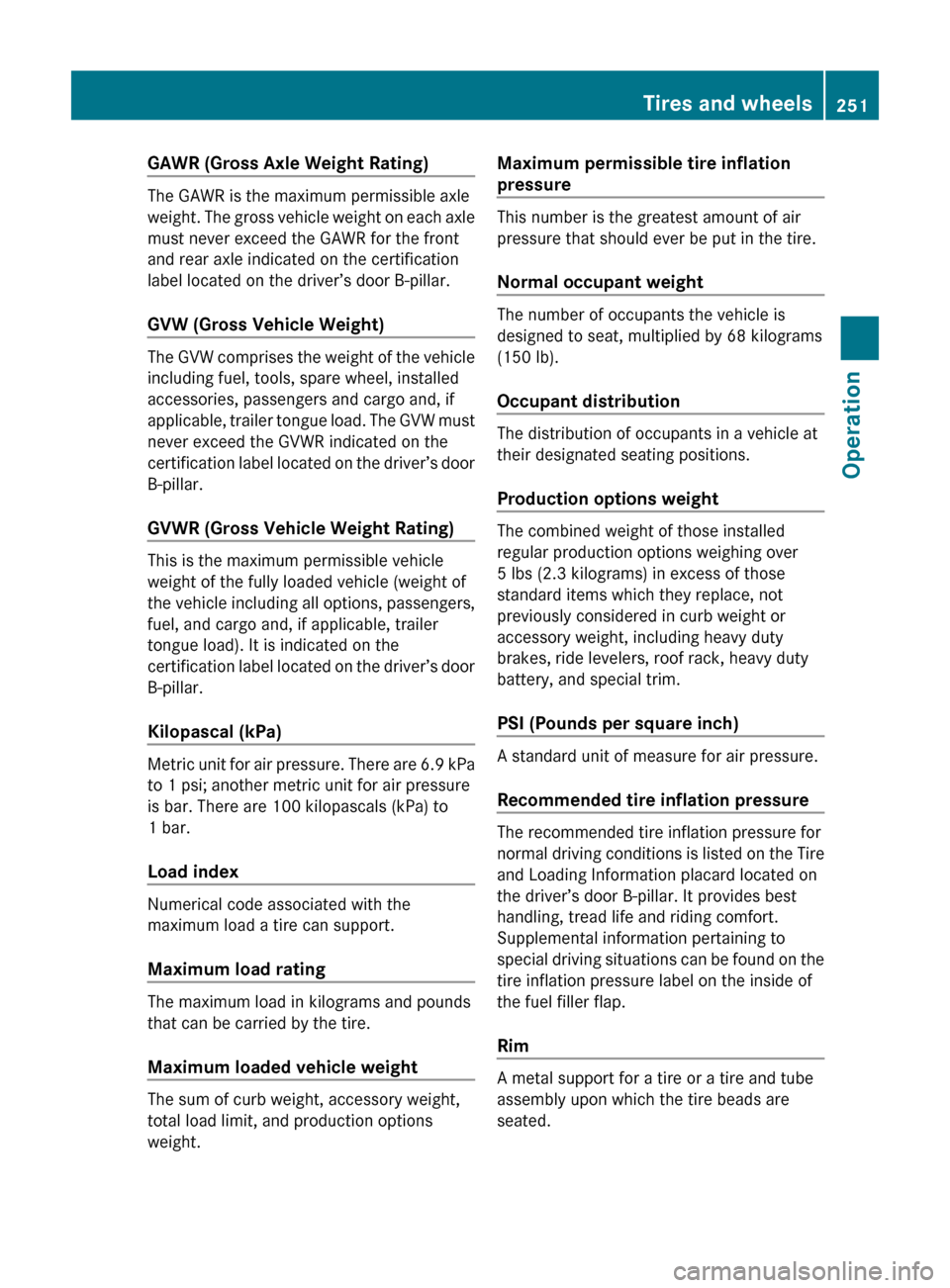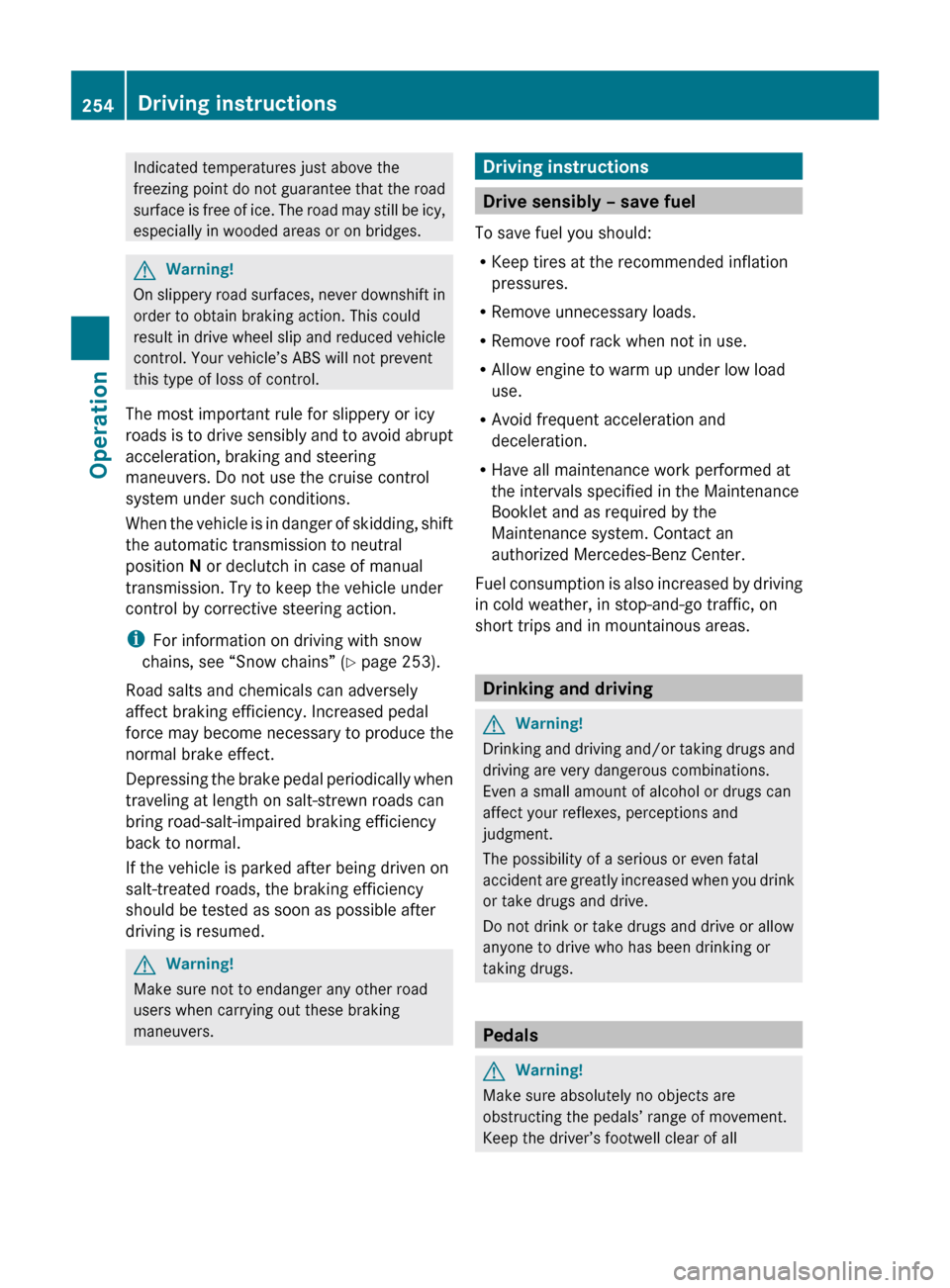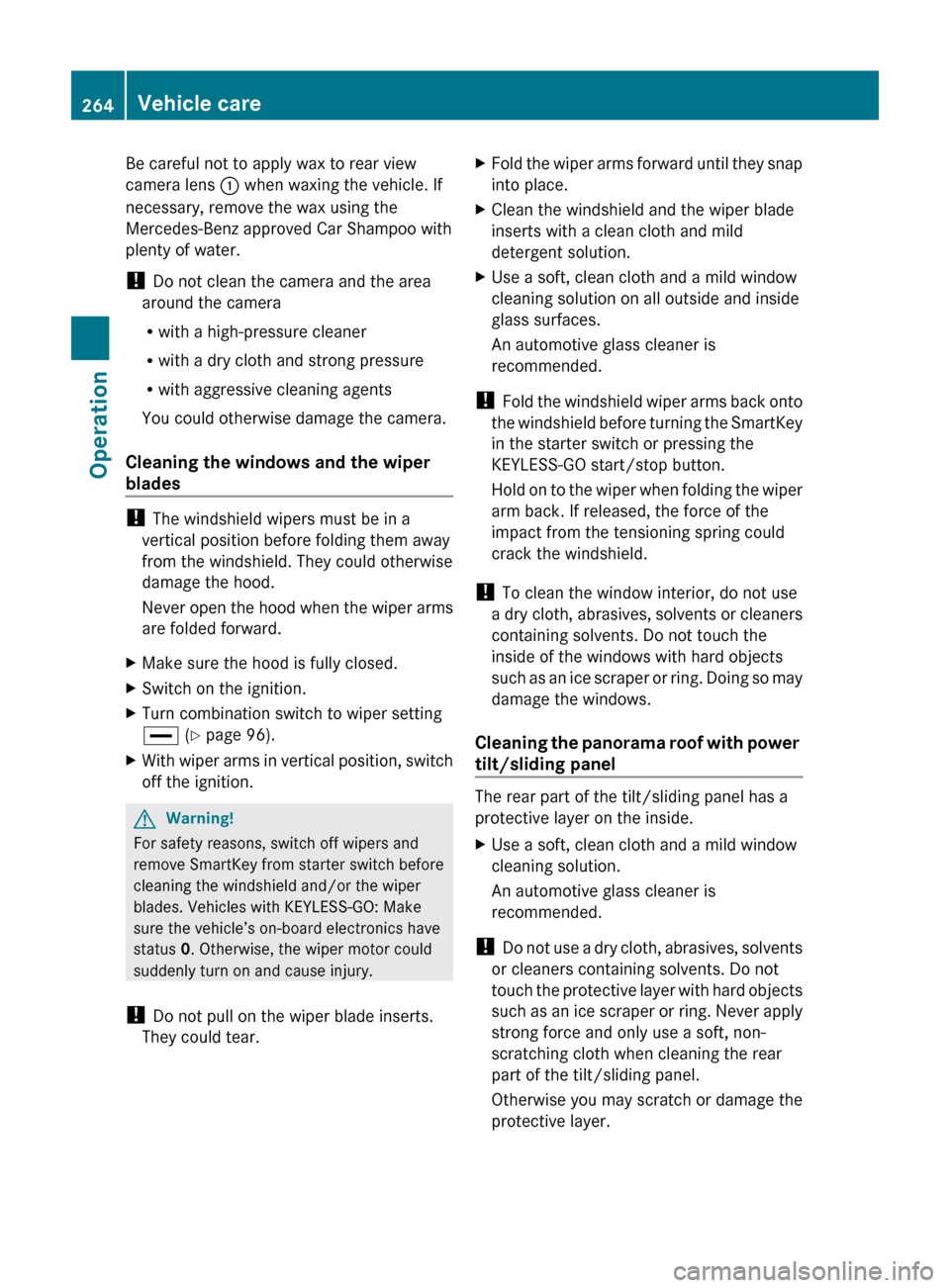2010 MERCEDES-BENZ C350S roof rack
[x] Cancel search: roof rackPage 16 of 364

Power assistance .............................. 255
Power outlets .................................... 210
Power seats see Seats
Power steering
Messages in the multifunction
display ........................................... 288
Power tilt/sliding sunroof
Operation ....................................... 196
Synchronizing ................................ 199
Power washer .................................... 261
Power windows ................................... 98
Cleaning ......................................... 264
Operation ......................................... 98
Rear door window, override
switch .............................................. 59
Synchronizing .................................. 99
Practical hints ................................... 268
Problems
While driving .................................. 104
With vehicle ..................................... 23
With wipers ...................................... 97
Product information ............................ 20
Production options weight ............... 251
Program mode selector switch
Automatic shift program ................111
Manual shift program ............113, 114
Proximity key
see Key, SmartKey
PSI (air pressure unit) ....................... 251
R
RACETIMER ........................................ 124
Radio .................................................. 148
Satellite radio ................................ 152
Selecting stations ..........................126
Radio transmitters ............................ 258
Rain sensor see Intermittent wiping
Rear axle oil ....................................... 351
Rear center console ashtray see Ashtrays
Rear doors
Child safety locks ............................ 59
Rear door window
Override switch ................................ 59
Rear fog lamp
see Fog lamps
Rear lamps
see Tail lamps
Rear seat head restraints
see Head restraints
Rear view camera .............................. 188
Cleaning the camera lens ..............263
Rear window defroster ..................... 196
Recommended tire inflation
pressure ..................................... 230, 251
Refrigerant, air conditioning ............ 354
Refueling ............................................ 222
Regular checks .................................. 224
Reminder, Seat belt see Seat belts, Telltale
Remote control
see Key, SmartKey
Remote door lock (Tele Aid) ............. 216
Remote door unlock (Tele Aid) ......... 215
Replacing
Key .................................................. 74
Replacing bulbs ................................. 313
Reporting safety defects .................... 23
Research Octane Number see RON
Reserve fuel
Messages in the multifunction
display ........................................... 291
Warning lamp ................................. 304
Restraint systems
see Occupant safety
Retaining hooks ................................. 203
Rims ........................................... 251, 344
Roadside Assistance ................... 21, 214
Roller sunblinds ................................. 199
RON (Research Octane Number) ..... 354
Roof rack ............................................ 203
Rubber parts, cleaning ...................... 265
S
Safety
Driving safety systems .....................60
Occupant safety ............................... 36
Reporting defects ............................ 23
Safety belts
see Seat belts
14Index204_AKB; 5; 23, en-USd2ureepe,Version: 2.11.8.12009-07-16T17:54:06+02:00 - Seite 14
Page 20 of 364

U
Uniform Tire Quality Grading
Standards .................................. 244, 252
Units
Selecting speedometer display
mode ............................................. 131
Unleaded gasoline, premium ........... 354
Unlocking the vehicle
KEYLESS-GO .................................... 71
Manually ........................................ 309
SmartKey ......................................... 70
Upholstery, cleaning ......................... 266
Useful features .................................. 207
V
Valet locking ........................................ 77
Vehicle
Battery ........................................... 321
Care ............................................... 260
Control system .............................. 118
Identification Number (VIN) ...........332
Locking/unlocking ........................... 70
Lowering (wheel change) ...............321
Modifications and alterations,
Operating safety .............................. 22
Towing ........................................... 325
Unlocking/locking manually ..........309
Vehicle dimensions
see Vehicle specification
Vehicle Identification Number
(VIN) ................................................... 332
Vehicle jack see Jack
Vehicle lighting .................................... 90
Vehicle loading
Cargo tie-down rings ...................... 203
Instructions .................................... 202
Load limit ....................................... 239
Roof rack ....................................... 203
Split rear seat bench .....................204
Terminology ................................... 250
Vehicle maximum load on the tire ... 252
Vehicle specification
C 250 ............................................. 334
C 250 4MATIC ............................... 335
C 250 4MATIC Sport ...................... 336
C 250 Sport ................................... 334
C 300 ............................................. 337
C 300 4MATIC ............................... 339
C 300 4MATIC Sport ...................... 340
C 300 Sport ................................... 338
C 350 ............................................. 341
C 350 4MATIC ............................... 343
C 350 Sport ................................... 342
C 63 AMG ...................................... 343
Vehicle status message memory .... 129
Vehicle tool kit .................................. 268
Vehicle washing see Vehicle care
Vehicle weights
see Vehicle specification
W
Warning sounds
Driver’s or passenger’s seat belt .....51
Parking brake ................................ 281
Parktronic system ..........................187
Seat belt telltale ............................ 301
Warranty coverage ............................ 332
Washer and headlamp cleaning
system ................................................ 358
Washer fluid
Mixing ratio .................................... 358
Refilling .......................................... 228
Washing the vehicle .......................... 260
Wear pattern (tires) .......................... 245
Weights (vehicle) see Vehicle specification
Wheel
Changing ....................................... 317
Removing ....................................... 320
Spare ............................................. 317
Tightening torque ........................... 321
Wheels, sizes ..................................... 344
Wheels, Tires and .............................. 229
Window curtain air bags ..................... 42
Windows see Power windows
Windows, cleaning ............................ 264
Windshield
Cleaning wiper blades .................... 264
Defogging ...................................... 195
18Index204_AKB; 5; 23, en-USd2ureepe,Version: 2.11.8.12009-07-16T17:54:06+02:00 - Seite 18
Page 205 of 364

Roof rack
For information about further roof rack
equipment, contact an authorized Mercedes-
Benz Center.
GWarning!
Only use roof racks approved by Mercedes-
Benz for your vehicle model to avoid damage
to the vehicle.
Follow the manufacturer’s installation
instructions. Otherwise, an improperly
attached roof rack system or its load could
become detached from the vehicle.
Do not exceed the maximum roof load of
220 lb (100 kg).
Take into consideration that when the roof
rack is loaded, the handling characteristics
are different from those when operating the
vehicle without the roof rack loaded.
Make sure
Ryou can raise the power tilt/sliding sunroof
or the panorama roof with tilt/sliding panel
completely
Ryou can open the trunk completely
XFlip trim covers : open.XOnly attach the roof rack to the anchorage
points under trim covers :.
XObserve manufacturer’s instructions for
installation.Parcel netsGWarning!
Parcel nets are intended for storing light-
weight items only, such as road maps, mail,
etc.
Heavy objects, objects with sharp edges, or
fragile objects may not be transported in the
parcel nets. In an accident, during hard
braking, or sudden maneuvers, they could be
thrown around inside the vehicle and cause
injury to vehicle occupants.
Parcel nets cannot protect transported goods
in the event of an accident.
Parcel nets are located in the front passenger
footwell and on the left trunk side wall.
Cargo tie-down rings
Vehicles with split rear seat bench are
equipped with four cargo tie-down rings.
Always follow loading instructions
(Y page 202).
Hooks
Two retaining hooks can be used to attach
cargo items such as bags.
! Do not use the retaining hooks to tie down
cargo.
Loading and storing203Controls in detail204_AKB; 5; 23, en-USd2ureepe,Version: 2.11.8.12009-07-16T17:54:06+02:00 - Seite 203Z
Page 235 of 364

Tire and Loading Information placard on the
driver’s door B-pillar ( Y page 238). If
necessary, add air to achieve the
recommended tire inflation pressure.XIf you have overfilled the tire, release tire
inflation pressure by pushing the metal
stem of the valve with e.g. a tip of a pen.
Then recheck the tire inflation pressure
with the tire gauge.XInstall the valve cap.XRepeat this procedure for each tire.
Tire pressure loss warning system
(Canada only)
While the vehicle is being driven, the tire
pressure loss warning system monitors the
set tire inflation pressures by evaluating each
wheel’s rotational speed. This allows the
system to detect a significant loss of pressure
in a tire. If a wheel’s rotational speed changes
due to falling tire inflation pressure, you will
see a corresponding warning message in the
multifunction display.
The tire pressure loss warning system may
function in a restricted manner or with a delay
R when snow chains are mounted to the
vehicle
R in the presence of ice and snow
R when you are driving on a loose surface
(e.g. sand or gravel)
R when you are driving in a very sporty
manner (involving rapid acceleration or
high speeds in curves)
R when you are driving with a loaded roof
rack or heavily laden vehicle
GWarning!
When the multifunction display shows the
message Check Tire Pressure Soon , one
or more of your tires are significantly
underinflated. You should stop and check
your tires as soon as possible, and inflate
them to the proper tire inflation pressure as
indicated on the vehicle’s Tire and Loading
Information placard or, if available, on the tire
inflation pressure label.
Driving on a significantly underinflated tire
causes the tire to overheat and can lead to
tire failure. Underinflation also reduces fuel
efficiency and tire tread life, and may affect
the vehicle’s handling and stopping ability.
Each tire, including the spare, should be
checked at least once a month when cold.
Inflate the tires to the recommended tire
inflation pressure as specified on
R the Tire and Loading Information placard on
the driver’s door B-pillar
or
R the tire inflation pressure label located on
the inside of the fuel filler flap
i The recommended tire inflation pressures
for your vehicle can be found on
R the Tire and Loading Information placard
located on the driver’s door B-pillar
( Y page 238)
R the tire inflation pressure label on the
inside of the fuel filler flap
The tire inflation pressures are not listed in
the Operator’s Manual.GWarning!
The tire pressure loss warning system does
not provide a warning for wrongly selected tire
inflation pressures. Always adjust tire
inflation pressure according to the Tire and
Loading Information placard on the driver’s
door B-pillar or on the tire inflation pressure
label located on the inside of the fuel filler flap.
The tire pressure loss warning system does
not replace regular checks of the tire inflation
pressures since a gradual pressure loss in
more than one tire cannot be detected by the
tire pressure loss warning system.
The tire pressure loss warning system is not
able to issue a warning due to a sudden
dramatic loss of tire inflation pressure (e.g.
Tires and wheels233Operation204_AKB; 5; 23, en-USd2ureepe,Version: 2.11.8.12009-07-16T17:54:06+02:00 - Seite 233Z
Page 253 of 364

GAWR (Gross Axle Weight Rating)
The GAWR is the maximum permissible axle
weight. The gross vehicle weight on each axle
must never exceed the GAWR for the front
and rear axle indicated on the certification
label located on the driver’s door B-pillar.
GVW (Gross Vehicle Weight)
The GVW comprises the weight of the vehicle
including fuel, tools, spare wheel, installed
accessories, passengers and cargo and, if
applicable, trailer tongue load. The GVW must
never exceed the GVWR indicated on the
certification label located on the driver’s door
B-pillar.
GVWR (Gross Vehicle Weight Rating)
This is the maximum permissible vehicle
weight of the fully loaded vehicle (weight of
the vehicle including all options, passengers,
fuel, and cargo and, if applicable, trailer
tongue load). It is indicated on the
certification label located on the driver’s door
B-pillar.
Kilopascal (kPa)
Metric unit for air pressure. There are 6.9 kPa
to 1 psi; another metric unit for air pressure
is bar. There are 100 kilopascals (kPa) to
1 bar.
Load index
Numerical code associated with the
maximum load a tire can support.
Maximum load rating
The maximum load in kilograms and pounds
that can be carried by the tire.
Maximum loaded vehicle weight
The sum of curb weight, accessory weight,
total load limit, and production options
weight.
Maximum permissible tire inflation
pressure
This number is the greatest amount of air
pressure that should ever be put in the tire.
Normal occupant weight
The number of occupants the vehicle is
designed to seat, multiplied by 68 kilograms
(150 lb).
Occupant distribution
The distribution of occupants in a vehicle at
their designated seating positions.
Production options weight
The combined weight of those installed
regular production options weighing over
5 lbs (2.3 kilograms) in excess of those
standard items which they replace, not
previously considered in curb weight or
accessory weight, including heavy duty
brakes, ride levelers, roof rack, heavy duty
battery, and special trim.
PSI (Pounds per square inch)
A standard unit of measure for air pressure.
Recommended tire inflation pressure
The recommended tire inflation pressure for
normal driving conditions is listed on the Tire
and Loading Information placard located on
the driver’s door B-pillar. It provides best
handling, tread life and riding comfort.
Supplemental information pertaining to
special driving situations can be found on the
tire inflation pressure label on the inside of
the fuel filler flap.
Rim
A metal support for a tire or a tire and tube
assembly upon which the tire beads are
seated.
Tires and wheels251Operation204_AKB; 5; 23, en-USd2ureepe,Version: 2.11.8.12009-07-16T17:54:06+02:00 - Seite 251Z
Page 256 of 364

Indicated temperatures just above the
freezing point do not guarantee that the road
surface is free of ice. The road may still be icy,
especially in wooded areas or on bridges.GWarning!
On slippery road surfaces, never downshift in
order to obtain braking action. This could
result in drive wheel slip and reduced vehicle
control. Your vehicle’s ABS will not prevent
this type of loss of control.
The most important rule for slippery or icy
roads is to drive sensibly and to avoid abrupt
acceleration, braking and steering
maneuvers. Do not use the cruise control
system under such conditions.
When the vehicle is in danger of skidding, shift
the automatic transmission to neutral
position N or declutch in case of manual
transmission. Try to keep the vehicle under
control by corrective steering action.
i For information on driving with snow
chains, see “Snow chains” ( Y page 253).
Road salts and chemicals can adversely
affect braking efficiency. Increased pedal
force may become necessary to produce the
normal brake effect.
Depressing the brake pedal periodically when
traveling at length on salt-strewn roads can
bring road-salt-impaired braking efficiency
back to normal.
If the vehicle is parked after being driven on
salt-treated roads, the braking efficiency
should be tested as soon as possible after
driving is resumed.
GWarning!
Make sure not to endanger any other road
users when carrying out these braking
maneuvers.
Driving instructions
Drive sensibly – save fuel
To save fuel you should:
R Keep tires at the recommended inflation
pressures.
R Remove unnecessary loads.
R Remove roof rack when not in use.
R Allow engine to warm up under low load
use.
R Avoid frequent acceleration and
deceleration.
R Have all maintenance work performed at
the intervals specified in the Maintenance
Booklet and as required by the
Maintenance system. Contact an
authorized Mercedes-Benz Center.
Fuel consumption is also increased by driving
in cold weather, in stop-and-go traffic, on
short trips and in mountainous areas.
Drinking and driving
GWarning!
Drinking and driving and/or taking drugs and
driving are very dangerous combinations.
Even a small amount of alcohol or drugs can
affect your reflexes, perceptions and
judgment.
The possibility of a serious or even fatal
accident are greatly increased when you drink
or take drugs and drive.
Do not drink or take drugs and drive or allow
anyone to drive who has been drinking or
taking drugs.
Pedals
GWarning!
Make sure absolutely no objects are
obstructing the pedals’ range of movement.
Keep the driver’s footwell clear of all
254Driving instructionsOperation
204_AKB; 5; 23, en-USd2ureepe,Version: 2.11.8.12009-07-16T17:54:06+02:00 - Seite 254
Page 266 of 364

Be careful not to apply wax to rear view
camera lens : when waxing the vehicle. If
necessary, remove the wax using the
Mercedes-Benz approved Car Shampoo with
plenty of water.
! Do not clean the camera and the area
around the camera
R with a high-pressure cleaner
R with a dry cloth and strong pressure
R with aggressive cleaning agents
You could otherwise damage the camera.
Cleaning the windows and the wiper
blades
! The windshield wipers must be in a
vertical position before folding them away
from the windshield. They could otherwise
damage the hood.
Never open the hood when the wiper arms
are folded forward.
XMake sure the hood is fully closed.XSwitch on the ignition.XTurn combination switch to wiper setting
° (Y page 96).XWith wiper arms in vertical position, switch
off the ignition.GWarning!
For safety reasons, switch off wipers and
remove SmartKey from starter switch before
cleaning the windshield and/or the wiper
blades. Vehicles with KEYLESS-GO: Make
sure the vehicle’s on-board electronics have
status 0. Otherwise, the wiper motor could
suddenly turn on and cause injury.
! Do not pull on the wiper blade inserts.
They could tear.
XFold the wiper arms forward until they snap
into place.XClean the windshield and the wiper blade
inserts with a clean cloth and mild
detergent solution.XUse a soft, clean cloth and a mild window
cleaning solution on all outside and inside
glass surfaces.
An automotive glass cleaner is
recommended.
! Fold the windshield wiper arms back onto
the windshield before turning the SmartKey
in the starter switch or pressing the
KEYLESS-GO start/stop button.
Hold on to the wiper when folding the wiper
arm back. If released, the force of the
impact from the tensioning spring could
crack the windshield.
! To clean the window interior, do not use
a dry cloth, abrasives, solvents or cleaners
containing solvents. Do not touch the
inside of the windows with hard objects
such as an ice scraper or ring. Doing so may
damage the windows.
Cleaning the panorama roof with power
tilt/sliding panel
The rear part of the tilt/sliding panel has a
protective layer on the inside.
XUse a soft, clean cloth and a mild window
cleaning solution.
An automotive glass cleaner is
recommended.
! Do not use a dry cloth, abrasives, solvents
or cleaners containing solvents. Do not
touch the protective layer with hard objects
such as an ice scraper or ring. Never apply
strong force and only use a soft, non-
scratching cloth when cleaning the rear
part of the tilt/sliding panel.
Otherwise you may scratch or damage the
protective layer.
264Vehicle careOperation
204_AKB; 5; 23, en-USd2ureepe,Version: 2.11.8.12009-07-16T17:54:06+02:00 - Seite 264
Page 336 of 364

Vehicle specification C 250 (204.052)
The quoted data apply only to the standard
vehicle. Contact an authorized Mercedes-
Benz Center for the corresponding data of all
special bodies and special equipment.
i The C 250 is available in Canada only.Engine C 250Engine, type272Mode of operation4-stroke engine,
gasoline injectionNo. of cylinders6Bore3.46 in (88.00 mm)Stroke2.69 in (68.40 mm)Total piston
displacement152.3 cu in
(2 496 cm 3
)Compression
ratio11.4:1Output acc. to
SAE J 1349 21201 hp/6
100 rpm
(150 kW/6 100 rpm)Maximum torque
acc. to SAE J 1349181 lb-ft/
2 900 - 5 500 rpm
(245 Nm/
2 900 - 5 500 rpm)Maximum engine
speed6 500 rpmFiring order1-4-3-6-2-5Poly-V-belt2 401 mmElectrical system C 250Alternator14 V/150 AStarter motor12 V/1.4 kWBattery12 V/74 AhElectrical system C 250Spark plugs, typeBosch Y 7 MPP33Spark plugs,
electrode gap0.031 in (0.8 mm)Spark plugs,
tightening torque15 - 18 lb-ft
(20 - 25 Nm)Main dimensions C 250Overall vehicle
length182.3 in (4 630 mm)Overall vehicle
width 2279.5 in (2
020 mm)Overall vehicle
height56.9 in (1 444 mm)Wheelbase108.7 in (2 760 mm)Track, front60.7 in (1 541 mm)Track, rear60.8 in (1 544 mm)Turning circle35.4 ft (10.8 m)Weights C 250Roof loadmax. 220 lb (100 kg)Trunk loadmax. 220 lb (100 kg)
Vehicle specification C 250 Sport
(204.052)
The quoted data apply only to the standard
vehicle. Contact an authorized Mercedes-
Benz Center for the corresponding data of all
special bodies and special equipment.
i The C 250 Sport is available in Canada
only.
21 Premium fuel required. Performance may vary with fuel octane rating.
22 Exterior rear view mirrors folded out.334Vehicle specification C 250 Sport (204.052)Technical data
204_AKB; 5; 23, en-USd2ureepe,Version: 2.11.8.12009-07-16T17:54:06+02:00 - Seite 334